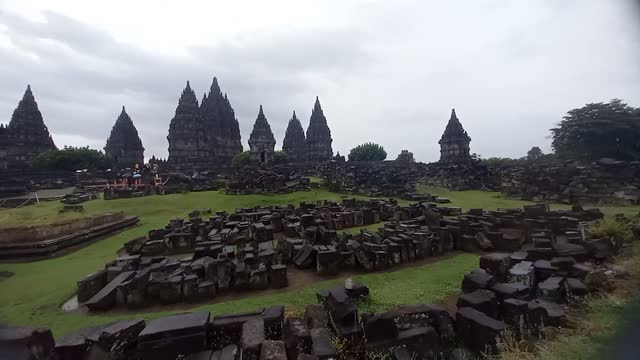Premium Only Content

Candi Prambanan
Prambanan Temple is the largest Hindu temple in Indonesia. Until now it is not certain when this temple was built and on whose orders, but it is strongly suspected that Prambanan Temple was built around the middle of the 9th century by the king of the Sanjaya dynasty, namely King Balitung Maha Sambu. The allegation is based on the contents of the Syiwagrha inscription found around Prambanan and currently stored in the National Museum in Jakarta. This inscription dated 778 Saka (856 AD) was written during the reign of Rakai Pikatan.
The original floor plan of Prambanan Temple is rectangular, consisting of an outer courtyard and three courtyards, namely Jaba (outer court), Tengahan (middle court) and Njeron (inner court). The outer courtyard is an open area that surrounds the outer court. The outer court is oblong with an area of 390 m2. This courtyard was once surrounded by a stone fence which is now in ruins. The outer court was currently just an empty courtyard. It is not known whether there were originally buildings or other decorations in this courtyard.
In the middle of the outer court, there is a second courtyard, namely the central courtyard which is rectangular in area of 222 m2. The central courtyard was also surrounded by a stone fence which is now crumbling. This courtyard consists of four terraces, the deeper the higher. On the first terrace, which is the lowest terrace, there are 68 small temples lined up around, divided into four rows by connecting roads between the courtyard doors. On the second terrace there are 60 temples, on the third terrace there are 52 temples, and on the fourth terrace, or the top terrace, there are 44 temples. All of the temples in the central courtyard have the same shape and size, namely the area of the base plan is 6 m2 and the height is 14 m. Almost all the temples in the central court are currently in a state of destruction. All that remains are ruins.
The inner court is the highest court and is considered the most sacred place. This courtyard has a rectangular floor area of 110 m2, with a height of about 1.5 m from the surface of the top terrace of the central court. The courtyard is surrounded by sheeting and stone fences. On all four sides there are gates in the form of a paduraksa gate. Currently only the gate on the south side is still intact. In front of each gate of the upper courtyard there are a pair of small temples, with a square base plan of 1.5 m2 with a height of 4 m.
In the inner court there are 2 rows of temples that stretch north and south. In the west row there are 3 temples facing east. The northernmost temple is the Vishnu Temple, in the middle is the Shiva Temple, and in the south is the Brahma Temple. In the east row there are also 3 temples facing west.
-
 2:05:33
2:05:33
TheSaltyCracker
5 hours agoTech Bros try to Hijack MAGA ReeEEeE Stream 12-27-24
135K333 -
 2:01:25
2:01:25
Roseanne Barr
10 hours ago $18.76 earnedJeff Dye | The Roseanne Barr Podcast #80
79.6K24 -
 7:32
7:32
CoachTY
8 hours ago $3.73 earnedWHALES ARE BUYING AND RETAIL IS SELLING. THIS IS WHY PEOPLE STAY BROKE!!!
32.9K7 -
 1:01:00
1:01:00
Talk Nerdy 2 Us
4 hours ago💻 From ransomware to global regulations, the digital battlefield is heating up!
11.8K1 -

I_Came_With_Fire_Podcast
7 hours agoHalf the Gov. goes MISSING, Trump day 1 Plans, IC finally tells the Truth, Jesus was NOT Palestinian
9.74K4 -
 4:11:49
4:11:49
Nerdrotic
9 hours ago $23.16 earnedThe Best and Worst of 2024! Sony Blames Fans | Batman DELAYED | Nosferatu! |Friday Night Tights 334
139K28 -
 7:55:51
7:55:51
Dr Disrespect
13 hours ago🔴LIVE - DR DISRESPECT - WARZONE - SHOTTY BOYS ATTACK
202K28 -
 1:30:23
1:30:23
Twins Pod
13 hours agoHe Went From MARCHING With BLM To Shaking Hands With TRUMP! | Twins Pod - Episode 45 - Amir Odom
120K29 -
 1:02:30
1:02:30
Exploring With Nug
14 hours ago $2.56 earned2 Duck Hunters Missing After Kayak Capsizes!
49.5K2 -
 46:48
46:48
Mally_Mouse
8 hours agoLet's Hang!! -- Opening Christmas gifts from YOU!
61.1K1